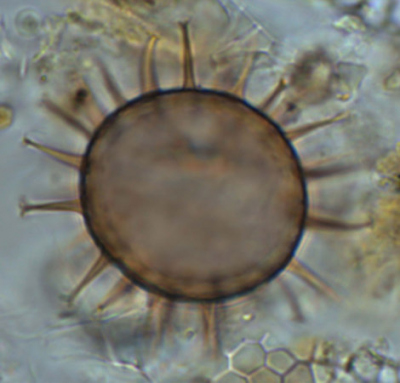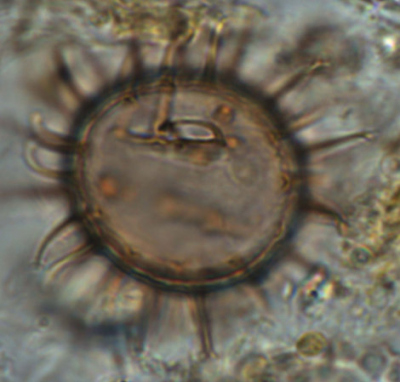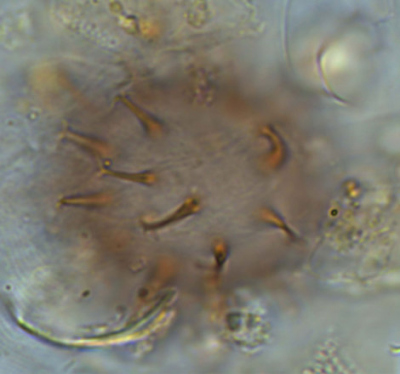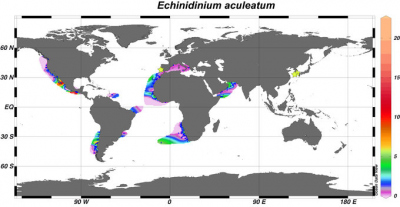Die Inhalte dieser Seite sind leider nicht auf Deutsch verfügbar.
Seitenpfad:
Echinidinium aculeatum
Zonneveld, K.A.F. and Pospelova V. (2015). A determination key for modern dinoflagellate cysts. Palynology 39 (3), 387- 409.

cross section Holotype
photo by Karin Zonneveld

dorsal view Holotype
photo by Karin Zonneveld

ventral view Holotype
photo by Karin Zonneveld
Field characteristics
Echinidinium aculeatum Zonneveld 1997
Characteristics:
Spheroidal brown cysts covered with randomly distributed spines. Cyst wall pigmented with a thin smooth pedium. The hollow, smooth spines are formed by separation of the luxuria and the pedium. Between the processes a luxuria of isolated granulae can be present. Spines are tapering towards their distal ends, with open aculeate distal tips which have two to four distal extremities. Spine bases are (sub)spherical. The chasmic archeopyle consists of a split along a single suture. No other tabulation is reflected although sometimes it looks if every process reflects the position of one plate.
Dimensions: Cyst body diameter: 16 to 26 µm; length of processes: 6 to 8 µm.
Motile affinity: Unknown.
Stratigraphic range: late Pleistocene to Recent.
Comparison with other species:
The way to distinguish Echinidinium species from each other is their spine/process characteristics and cyst wall ornamentation. On several specimens of E. aculeatum it seems that there is sometimes paratabulation reflected by the processes; one spine per plate. The archeopyle is often not visible. The cysts may appear pale-grayisch brown in colour and are often very thin. They have less than 50 processes. Processes are hollow and differ from all the other spiny blown species in being aculeate.
Characteristics:
Spheroidal brown cysts covered with randomly distributed spines. Cyst wall pigmented with a thin smooth pedium. The hollow, smooth spines are formed by separation of the luxuria and the pedium. Between the processes a luxuria of isolated granulae can be present. Spines are tapering towards their distal ends, with open aculeate distal tips which have two to four distal extremities. Spine bases are (sub)spherical. The chasmic archeopyle consists of a split along a single suture. No other tabulation is reflected although sometimes it looks if every process reflects the position of one plate.
Dimensions: Cyst body diameter: 16 to 26 µm; length of processes: 6 to 8 µm.
Motile affinity: Unknown.
Stratigraphic range: late Pleistocene to Recent.
Comparison with other species:
The way to distinguish Echinidinium species from each other is their spine/process characteristics and cyst wall ornamentation. On several specimens of E. aculeatum it seems that there is sometimes paratabulation reflected by the processes; one spine per plate. The archeopyle is often not visible. The cysts may appear pale-grayisch brown in colour and are often very thin. They have less than 50 processes. Processes are hollow and differ from all the other spiny blown species in being aculeate.
Geographic distribution
Geographic distribution based on:
Zonneveld et al., 2013. Atlas of modern dinoflagellate cyst distribution based on 2405 datapoints. Review of Palaeobotany and Palynology, v. 191, 1-197
Echinidinium aculeatum can be regarded as a mesotrophic/eutrophic temperate to equatorial species occurring only in regions with unstratified upper waters. It is not observed in areas with well-ventilated bottom waters.
Zonneveld et al., 2013. Atlas of modern dinoflagellate cyst distribution based on 2405 datapoints. Review of Palaeobotany and Palynology, v. 191, 1-197
Echinidinium aculeatum can be regarded as a mesotrophic/eutrophic temperate to equatorial species occurring only in regions with unstratified upper waters. It is not observed in areas with well-ventilated bottom waters.

Distribution:
With the exception of a few sites, E. aculeatum is restricted to the coastal regions of temperate to equatorial regions. Highest abundances (up to 19%) occur in the vicinity of the active upwelling cells off Mexico, off Chili and off NW Africa.
Environmental parameter range:
SST: 7.8 - 29.8°C (winter - summer) with the exception of one site in the northeastern Pacific with SST: -1.3, -0.8, 4.4 and -0.8°C (winter, spring, summer, autumn), SSS: 26.8 - 38.5, [P]: 0.1 - 1.1 μmol/l, [N]: 0.4 - 9.6 μmol/l, chlorophyll-a: 0.1 - 18.8 ml/l, bottom water [O2]: 0.3 - 6.1 ml/l.
Abundances >5% occur in subtropical/tropical regions with SST of 19.9 - 29.7°C (winter - summer) with mesotrophic to eutrophic conditions where [P]: 0.3 - 0.8 μmol/l [N]: 0.3 - 5.0 μmol/l and high chlorophyll-a concentrations of 0.5 - 17.4 ml/l. These are mainly upwelling areas where large inter-annual variability in the trophic state of the surface waters can occur with eutrophic conditions during active upwelling or when upwelling filaments cross the sampling site and oligotrophic conditions when upwelling is absent.
E. aculeatum is restricted to sites with a small seasonal salinity range. It is not observed in the vicinity of river plumes or other regions where SSS are reduced. Highest relative abundances occur in regions with hypoxic bottom waters.
Comparison with other records:
Apart from the observations presented in this Atlas E. aculeatum has recently been reported from eutrophic bays with unstratified upper waters in southern Korea (Pospelova and Kim, 2010; Krepakevich and Pospelova, 2010; Shin et al., 2010a, b), British Columbia (Krepakevich and Pospelova, 2010) and the upwelling area off Portugal (Ribeiro; and Amorim, 2008). In the North Pacific E. aculeatum has not been observed in regions with sea ice (Radi and de Vernal, 2008). A sediment trap study of the central Georgia Strait (BC, Canada) documents cyst production in spring when Fraser River outflow is highest but with upper water salinities >24 (Pospelova et al., 2010). In the nearby Saanich Inlet (BC, Canada) higher production of this species occurs when diatom production is enhanced (Price and Pospelova, 2011). In the upwelling areas off Somalia and off NW Africa, E. aculeatum is produced during active upwelling and the upwelling initiation phase respectively (Zonneveld and Brummer, 2000; Zonneveld et al., 2010).
With the exception of a few sites, E. aculeatum is restricted to the coastal regions of temperate to equatorial regions. Highest abundances (up to 19%) occur in the vicinity of the active upwelling cells off Mexico, off Chili and off NW Africa.
Environmental parameter range:
SST: 7.8 - 29.8°C (winter - summer) with the exception of one site in the northeastern Pacific with SST: -1.3, -0.8, 4.4 and -0.8°C (winter, spring, summer, autumn), SSS: 26.8 - 38.5, [P]: 0.1 - 1.1 μmol/l, [N]: 0.4 - 9.6 μmol/l, chlorophyll-a: 0.1 - 18.8 ml/l, bottom water [O2]: 0.3 - 6.1 ml/l.
Abundances >5% occur in subtropical/tropical regions with SST of 19.9 - 29.7°C (winter - summer) with mesotrophic to eutrophic conditions where [P]: 0.3 - 0.8 μmol/l [N]: 0.3 - 5.0 μmol/l and high chlorophyll-a concentrations of 0.5 - 17.4 ml/l. These are mainly upwelling areas where large inter-annual variability in the trophic state of the surface waters can occur with eutrophic conditions during active upwelling or when upwelling filaments cross the sampling site and oligotrophic conditions when upwelling is absent.
E. aculeatum is restricted to sites with a small seasonal salinity range. It is not observed in the vicinity of river plumes or other regions where SSS are reduced. Highest relative abundances occur in regions with hypoxic bottom waters.
Comparison with other records:
Apart from the observations presented in this Atlas E. aculeatum has recently been reported from eutrophic bays with unstratified upper waters in southern Korea (Pospelova and Kim, 2010; Krepakevich and Pospelova, 2010; Shin et al., 2010a, b), British Columbia (Krepakevich and Pospelova, 2010) and the upwelling area off Portugal (Ribeiro; and Amorim, 2008). In the North Pacific E. aculeatum has not been observed in regions with sea ice (Radi and de Vernal, 2008). A sediment trap study of the central Georgia Strait (BC, Canada) documents cyst production in spring when Fraser River outflow is highest but with upper water salinities >24 (Pospelova et al., 2010). In the nearby Saanich Inlet (BC, Canada) higher production of this species occurs when diatom production is enhanced (Price and Pospelova, 2011). In the upwelling areas off Somalia and off NW Africa, E. aculeatum is produced during active upwelling and the upwelling initiation phase respectively (Zonneveld and Brummer, 2000; Zonneveld et al., 2010).


